Abstract
Squirrel monkeys operated a key under second-order schedules in which every tenth completion of a 5-minute fixed interval resulted in either presentation of food or intravenous injection of cocaine. When a 2-second light was presented at the completion of the component fixed-interval schedules, positively accelerated responding developed and was maintained in each component. Over a tenfold range of doses of cocaine(30 to 300 microgram/kg/injection) and amounts of food (0.75 to 7.5 g/presentation); the second-order schedule of cocaine injection maintained higher average rates of responding than the second-order schedule of food presentation. Substituting saline for cocaine or eliminating food presentation decreased average rates of responding. When no stimulus change occurred at the completion of the first nine component fixed-interval schedules, but the 2-second light and food presentation or cocaine injection still occurred after the tenth component, only low and relatively constant rates of responding were maintained in each component. Patterns of responding characteristic of 5-minute fixed-interval schedules were maintained by the 2-second light paired with either cocaine injection or food presentation, though the maximum frequency of cocaine injection or food presentation was less than once per 50 minutes.
Full text
PDF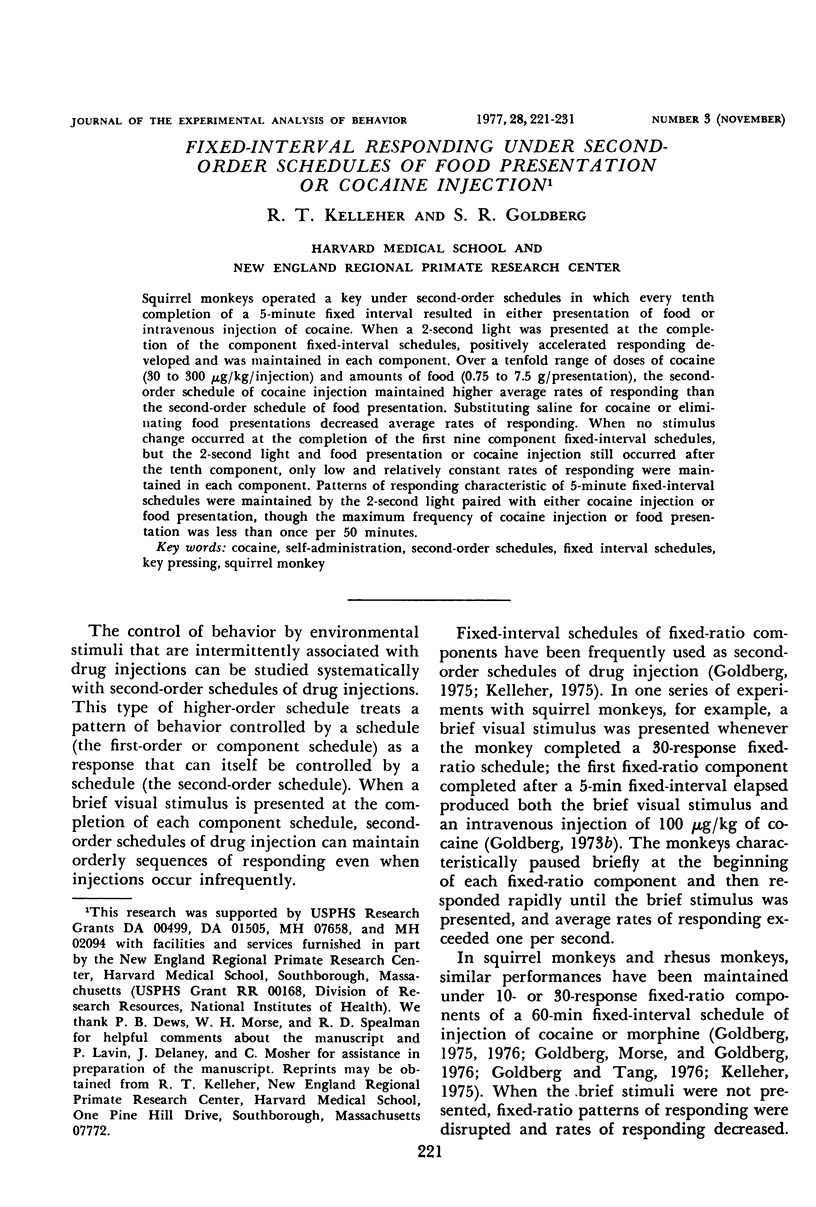
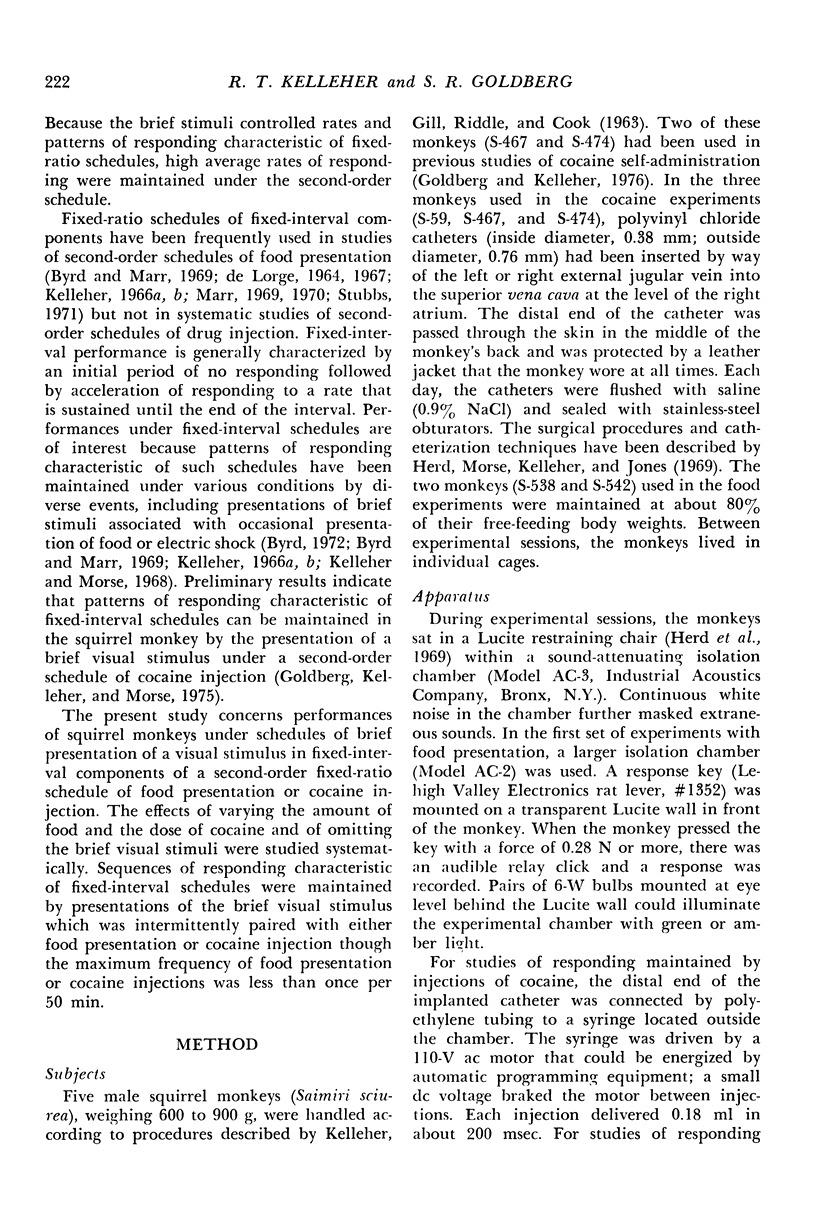
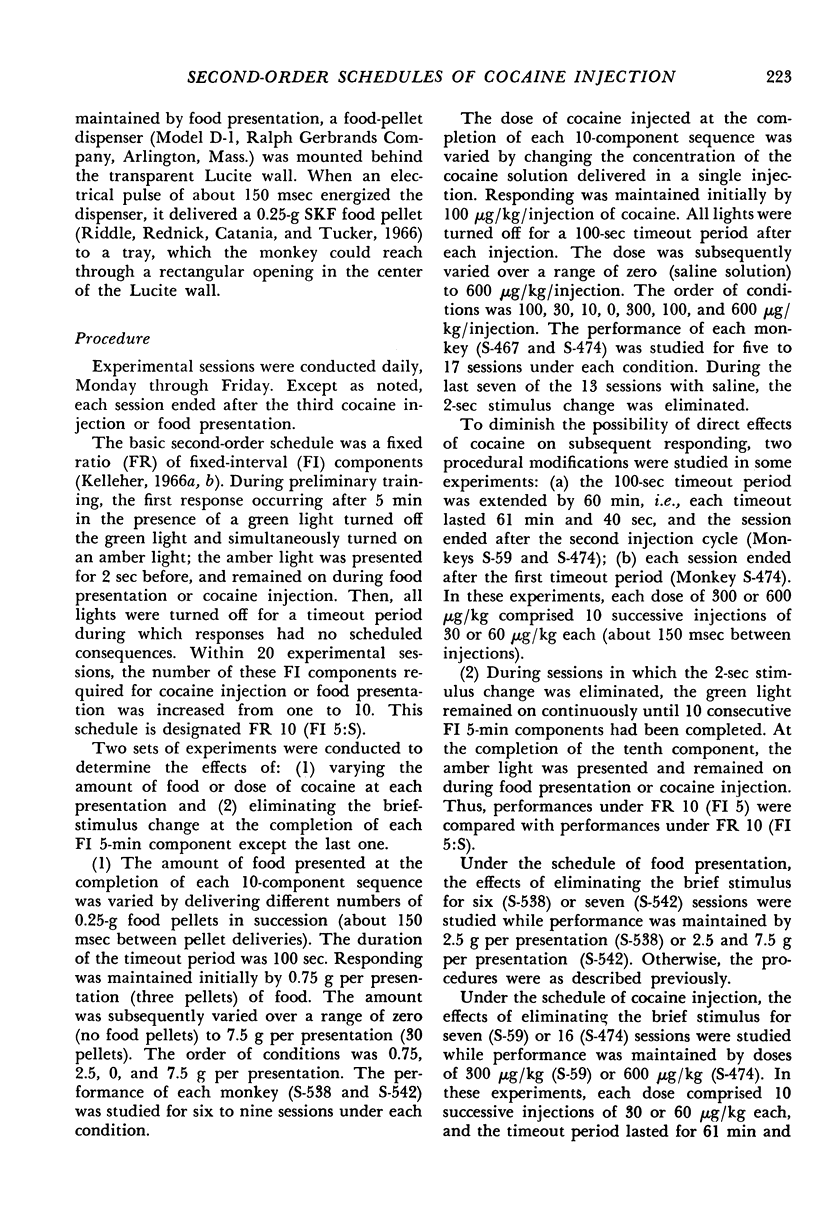
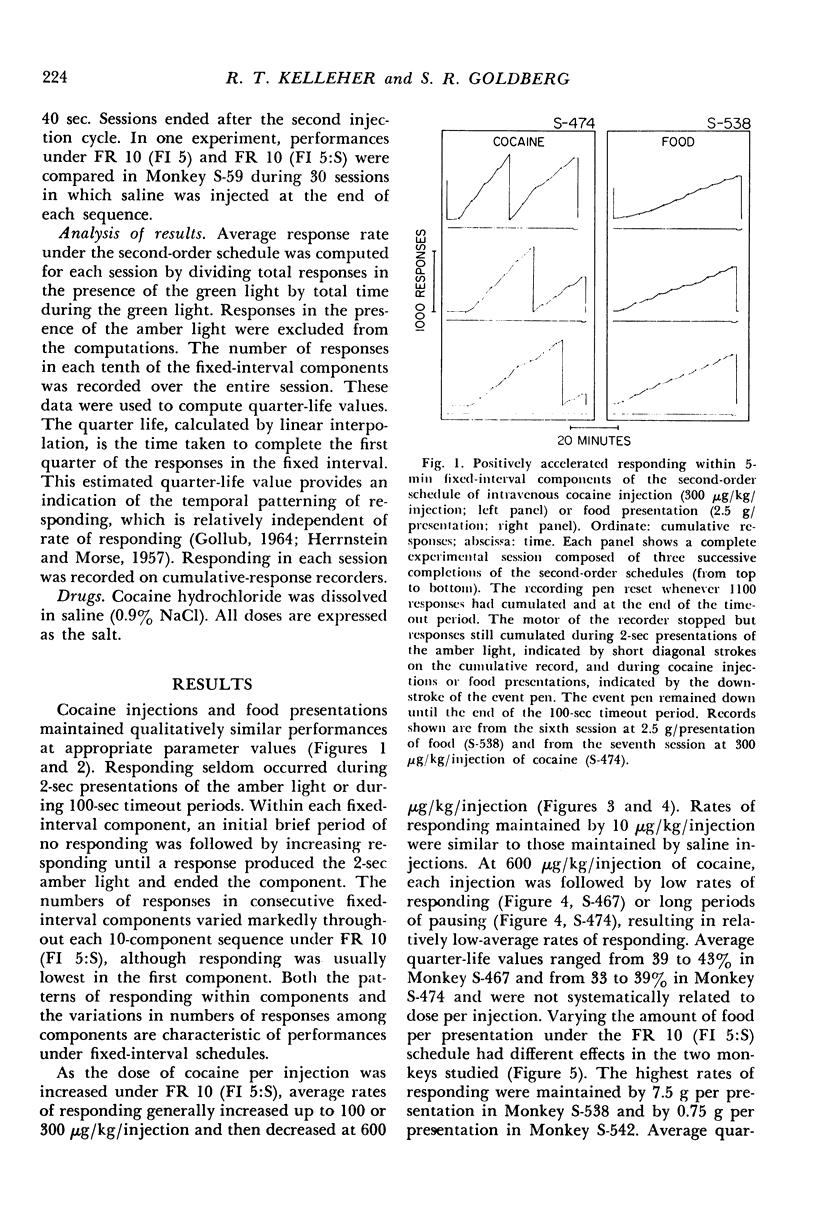
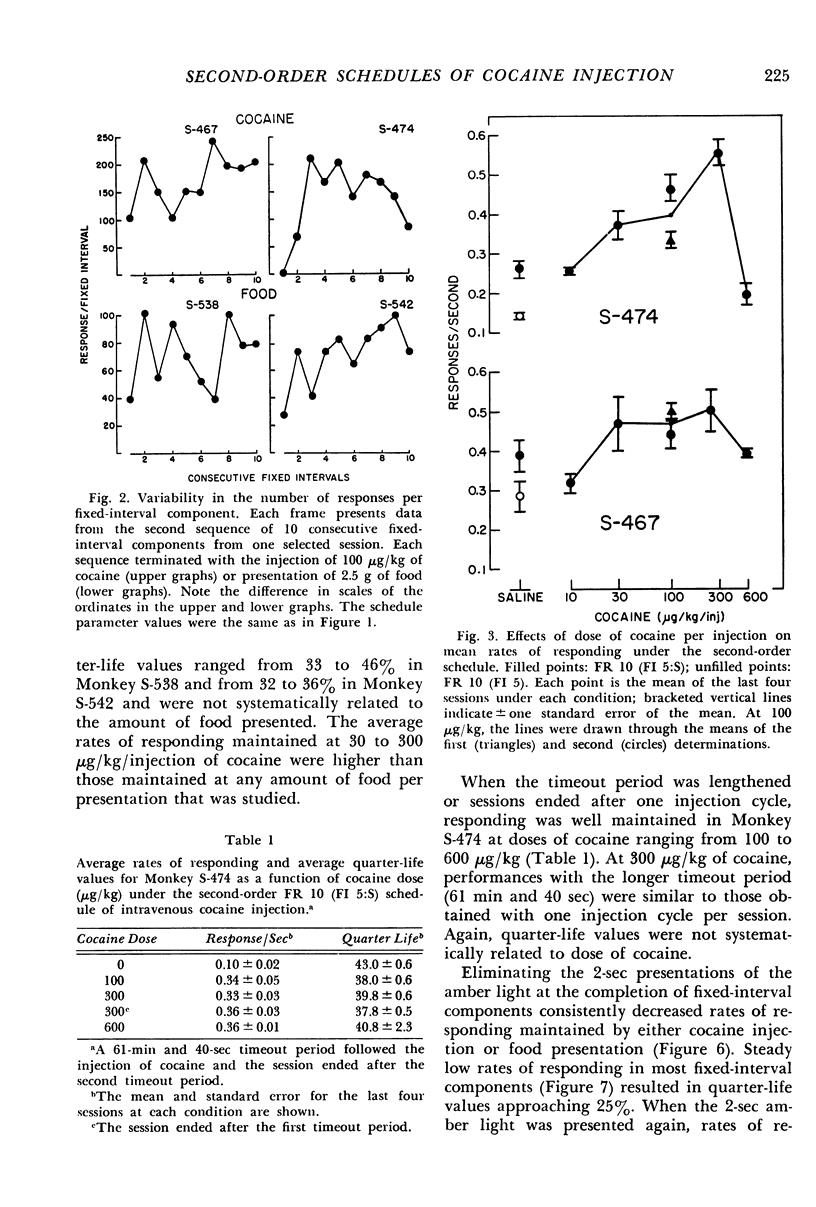
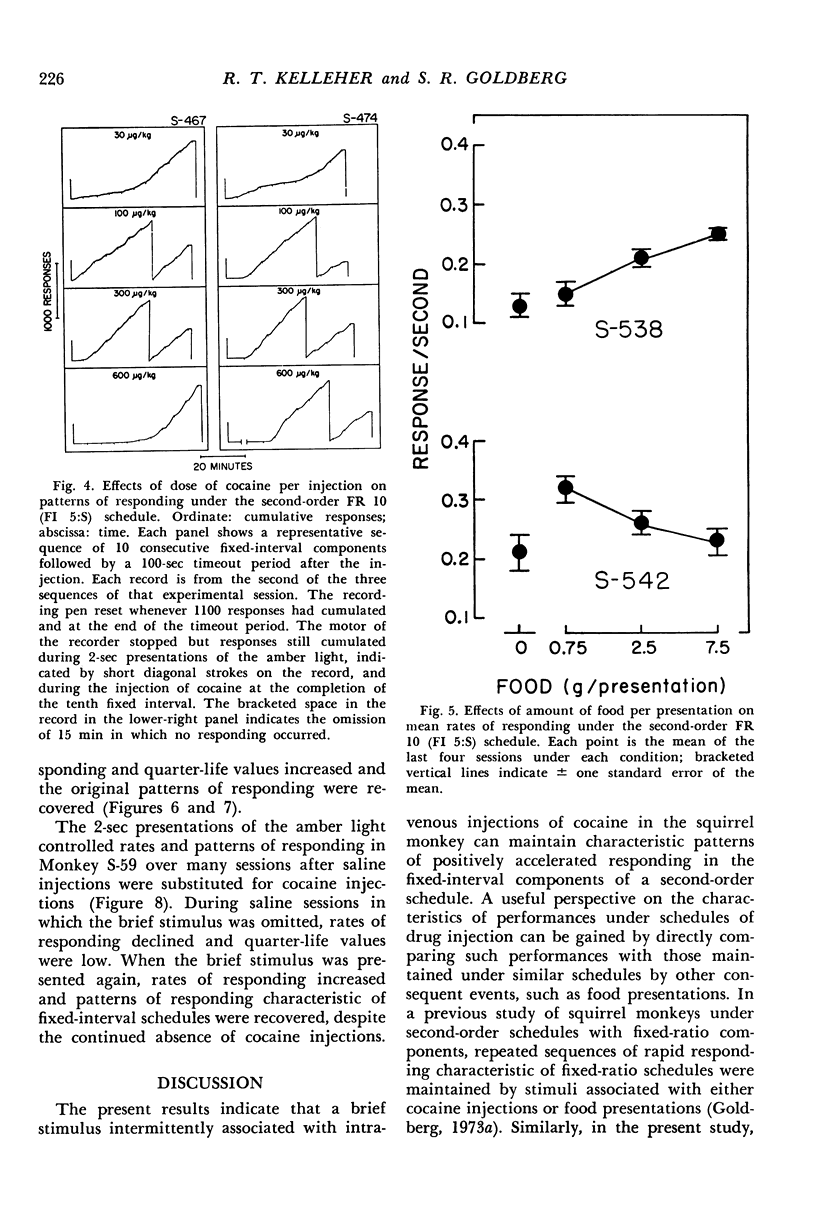
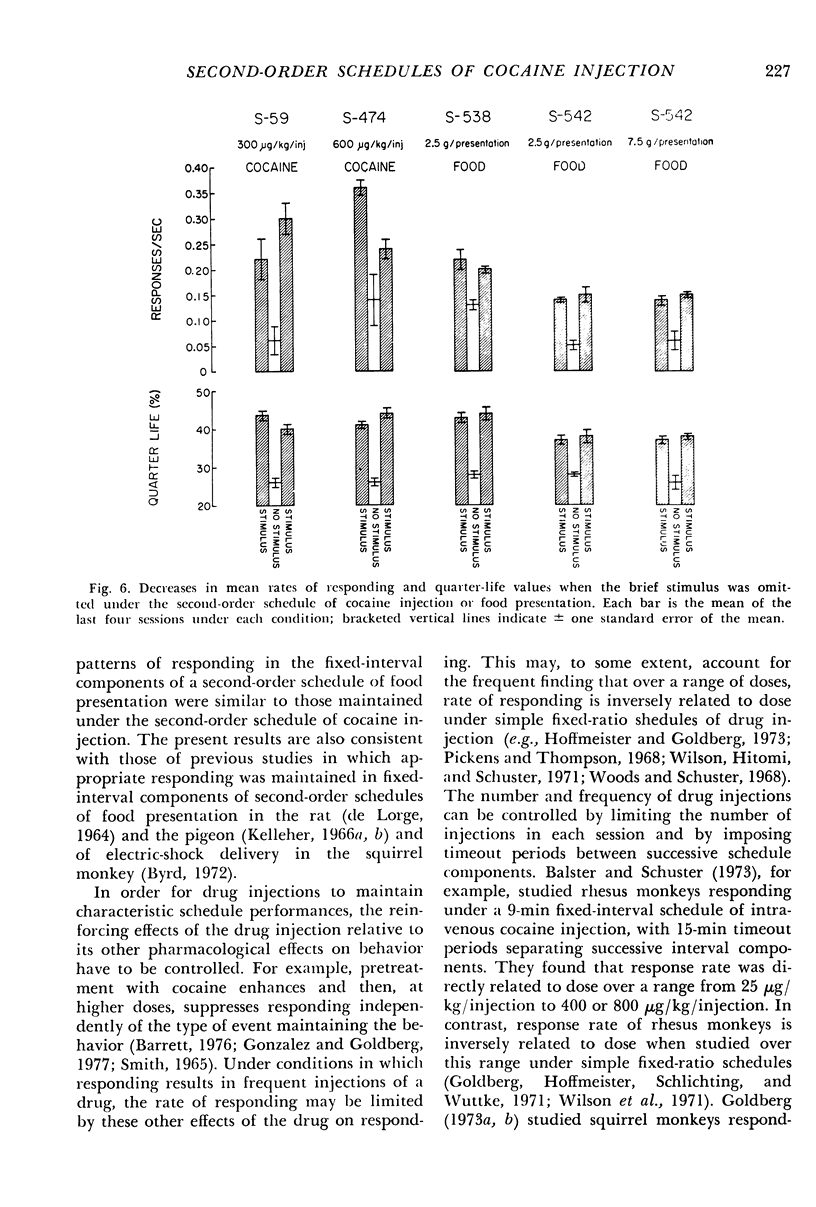
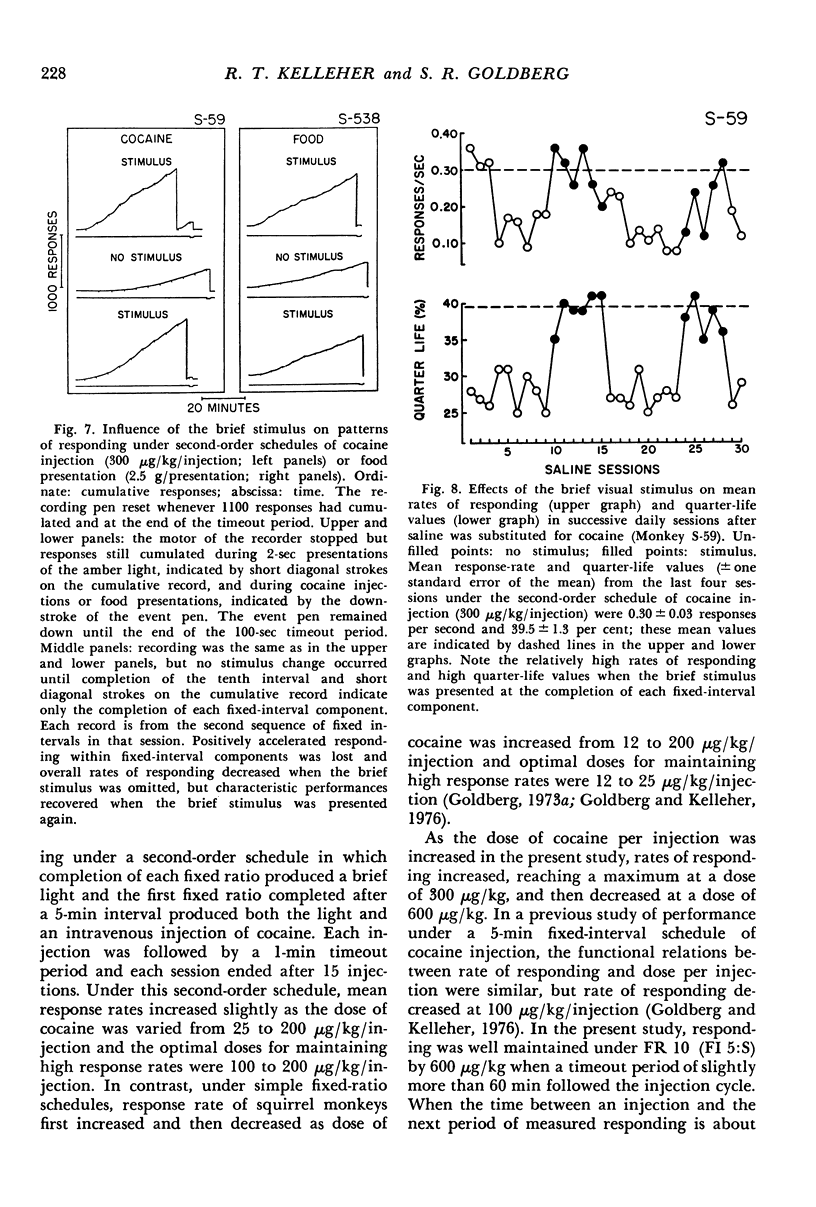
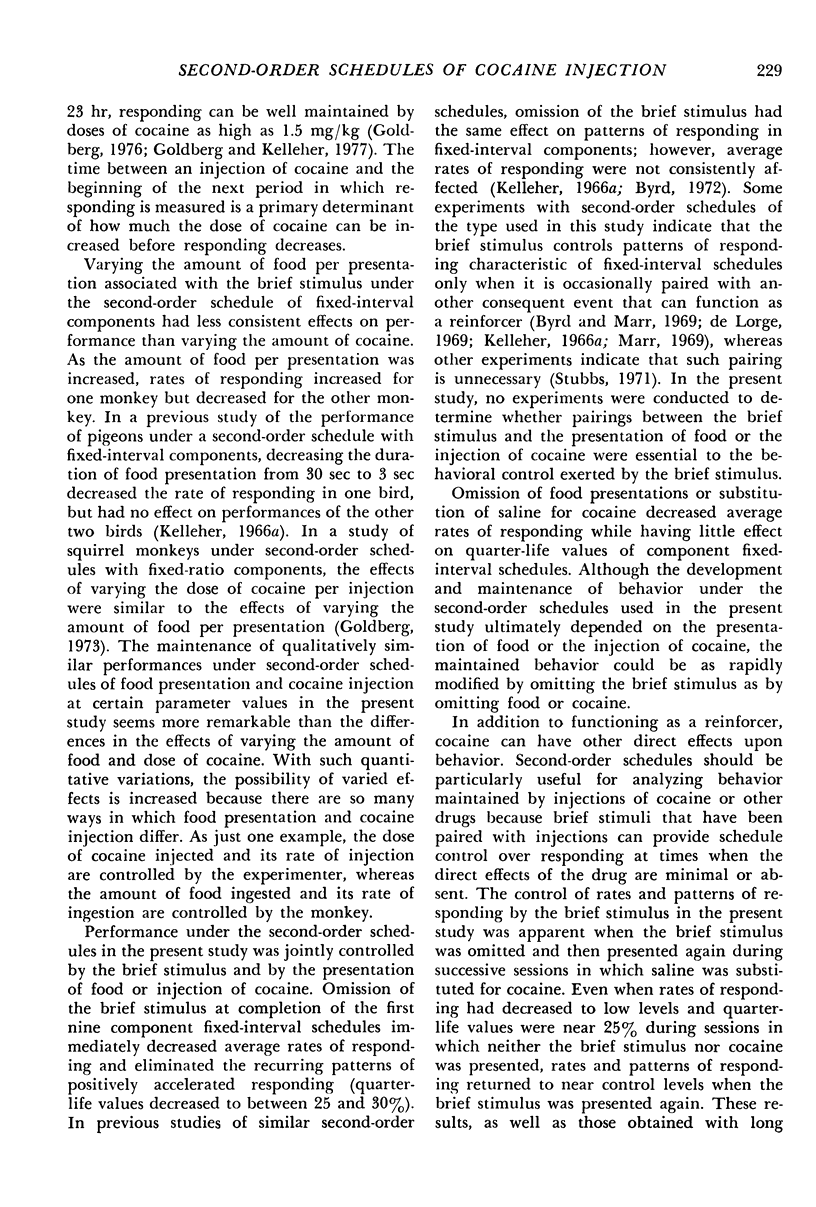
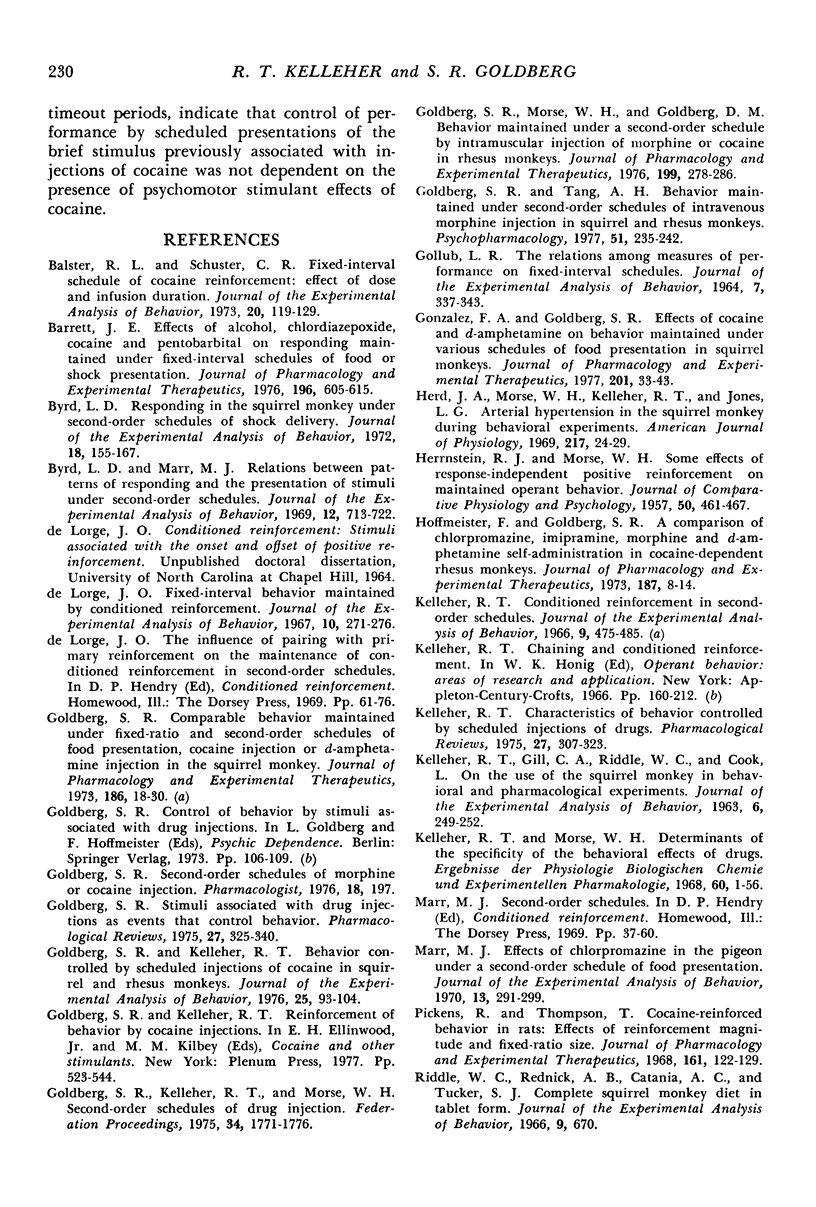
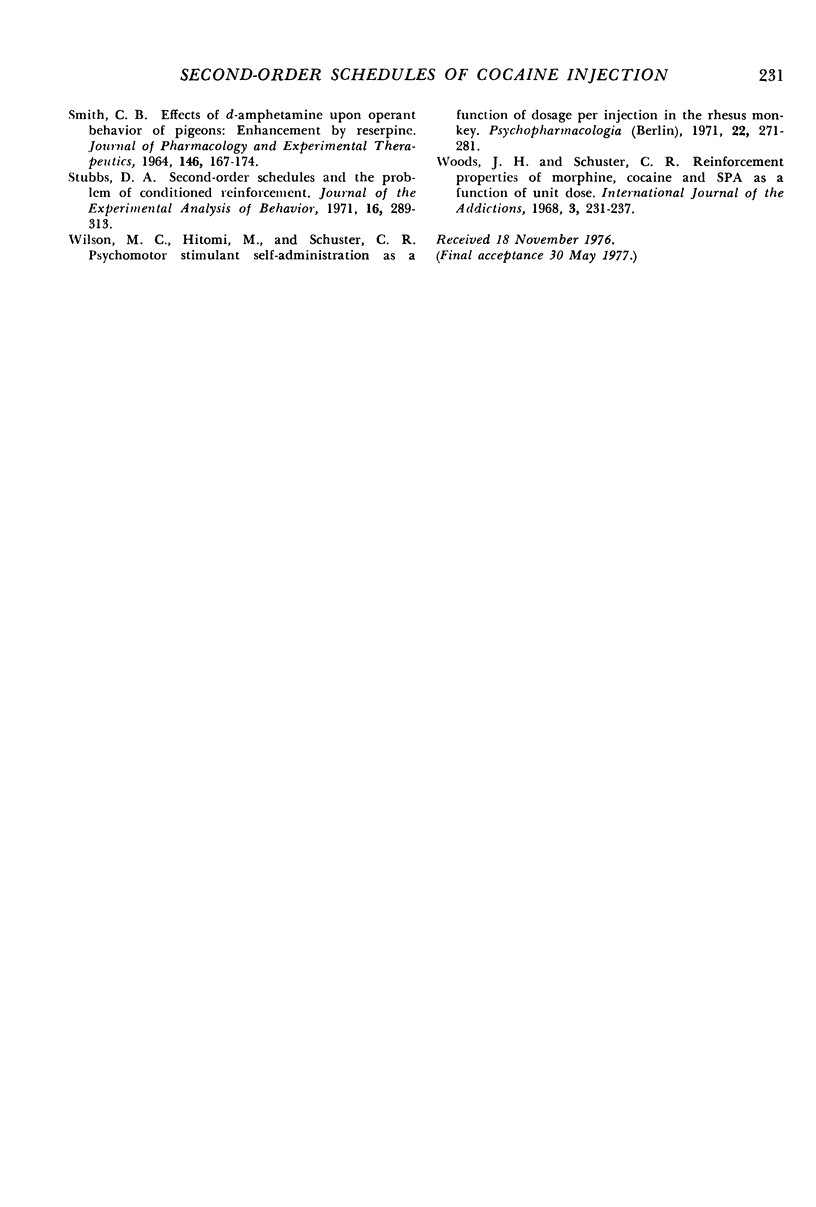
Selected References
These references are in PubMed. This may not be the complete list of references from this article.
- Balster R. L., Schuster C. R. Fixed-interval schedule of cocaine reinforcement: effect of dose and infusion duration. J Exp Anal Behav. 1973 Jul;20(1):119–129. doi: 10.1901/jeab.1973.20-119. [DOI] [PMC free article] [PubMed] [Google Scholar]
- Barrett J. E. Effects of alcohol, chlordiazepoxide, cocaine and pentobarbital on responding maintained under fixed-interval schedules of food or shock presentation. J Pharmacol Exp Ther. 1976 Mar;196(3):605–615. [PubMed] [Google Scholar]
- Byrd L. D., Marr M. J. Relations between patterns of responding and the presentation of stimuli under second-order schedules. J Exp Anal Behav. 1969 Sep;12(5):713–722. doi: 10.1901/jeab.1969.12-713. [DOI] [PMC free article] [PubMed] [Google Scholar]
- Byrd L. D. Responding in the squirrel monkey under second-order schedules of shock delivery. J Exp Anal Behav. 1972 Jul;18(1):155–167. doi: 10.1901/jeab.1972.18-155. [DOI] [PMC free article] [PubMed] [Google Scholar]
- De Lorge J. Fixed-interval behavior maintained by conditioned reinforcement. J Exp Anal Behav. 1967 May;10(3):271–276. doi: 10.1901/jeab.1967.10-271. [DOI] [PMC free article] [PubMed] [Google Scholar]
- GOLLUB L. R. THE RELATIONS AMONG MEASURES OF PERFORMANCE ON FIXED-INTERVAL SCHEDULES. J Exp Anal Behav. 1964 Sep;7:337–343. doi: 10.1901/jeab.1964.7-337. [DOI] [PMC free article] [PubMed] [Google Scholar]
- Goldberg S. R. Comparable behavior maintained under fixed-ratio and second-order schedules of food presentation, cocaine injection or d-amphetamine injection in the squirrel monkey. J Pharmacol Exp Ther. 1973 Jul;186(1):18–30. [PubMed] [Google Scholar]
- Goldberg S. R., Kelleher R. T., Morse W. H. Second-order schedules of drug injection. Fed Proc. 1975 Aug;34(9):1771–1776. [PubMed] [Google Scholar]
- Goldberg S. R., Morse W. H., Goldberg D. M. Behavior maintained under a second-order schedule by intramuscular injection of morphine or cocaine in rhesus monkeys. J Pharmacol Exp Ther. 1976 Oct;199(1):278–286. [PubMed] [Google Scholar]
- Goldberg S. R. Stimuli associated with drug injections as events that control behavior. Pharmacol Rev. 1975 Sep;27(3):325–340. [PubMed] [Google Scholar]
- Goldberg S. R., Tang A. H. Behavior maintained under second-order schedules of intravenous morphine injection in squirrel and rhesus monkeys. Psychopharmacology (Berl) 1977 Mar 16;51(3):235–242. doi: 10.1007/BF00431630. [DOI] [PubMed] [Google Scholar]
- Goldberg S. T., Kelleher R. T. Behavior controlled by scheduled injections of cocaine in squirrel and rhesus monkeys. J Exp Anal Behav. 1976 Jan;25(1):93–104. doi: 10.1901/jeab.1976.25-93. [DOI] [PMC free article] [PubMed] [Google Scholar]
- Gonzalez F. A., Goldberg S. R. Effects of cocaine and d-amphetamine on behavior maintained under various schedules of food presentation in squirrel monkeys. J Pharmacol Exp Ther. 1977 Apr;201(1):33–43. [PubMed] [Google Scholar]
- HERRNSTEIN R. J., MORSE W. H. Some effects of response-independent positive reinforcement on maintained operant behavior. J Comp Physiol Psychol. 1957 Oct;50(5):461–467. doi: 10.1037/h0041506. [DOI] [PubMed] [Google Scholar]
- Herd J. A., Morse W. H., Kelleher R. T., Jones L. G. Arterial hypertension in the squirrel monkey during behavioral experiments. Am J Physiol. 1969 Jul;217(1):24–29. doi: 10.1152/ajplegacy.1969.217.1.24. [DOI] [PubMed] [Google Scholar]
- Hoffmeister F., Goldberg S. R. A comparison of chlorpromazine, imipramine, morphine and d-amphetamine self-administration in cocaine-dependent rhesus monkeys. J Pharmacol Exp Ther. 1973 Oct;187(1):8–14. [PubMed] [Google Scholar]
- KELLEHER R. T., GILL C. A., RIDDLE W. C., COOK L. On the use of the squirrel monkey in behavioral and pharmacological experiments. J Exp Anal Behav. 1963 Apr;6:249–252. doi: 10.1901/jeab.1963.6-249. [DOI] [PMC free article] [PubMed] [Google Scholar]
- Kelleher R. T. Characteristics of behavior controlled by scheduled injections of drugs. Pharmacol Rev. 1975 Sep;27(3):307–323. [PubMed] [Google Scholar]
- Kelleher R. T., Morse W. H. Determinants of the specificity of behavioral effects of drugs. Ergeb Physiol. 1968;60:1–56. doi: 10.1007/BFb0107250. [DOI] [PubMed] [Google Scholar]
- Marr M. J. Effects of chlorpromazine in the pigeon under a second-order schedule of food presentation. J Exp Anal Behav. 1970 May;13(3):291–299. doi: 10.1901/jeab.1970.13-291. [DOI] [PMC free article] [PubMed] [Google Scholar]
- Pickens R., Thompson T. Cocaine-reinforced behavior in rats: effects of reinforcement magnitude and fixed-ratio size. J Pharmacol Exp Ther. 1968 May;161(1):122–129. [PubMed] [Google Scholar]
- Riddle W. C., Rednick A. B., Catania A. C., Tucker S. J. Complete squirrel monkey diet in tablet form. J Exp Anal Behav. 1966 Nov;9(6):670–670. doi: 10.1901/jeab.1966.9-670. [DOI] [PMC free article] [PubMed] [Google Scholar]
- Wilson M. C., Hitomi M., Schuster C. R. Psychomotor stimulant self administration as a function of dosage per injection in the rhesus monkey. Psychopharmacologia. 1971;22(3):271–281. doi: 10.1007/BF00401789. [DOI] [PubMed] [Google Scholar]


